In this article I have explained how to make a low cost yet fully automatic hand sanitizer dispenser circuit which will allow a touch-free or contactless dispensing of the sanitizing liquid on the user's hands.
This contactless hand sanitizer circuit facilitates the user to access the sanitizing liquid on hands automatically without the need of operating or touching the sanitizer bottle pump manually. The feature ensures that viruses have no chance of spreading through physical touching of the sanitizer bottle and its operating parts.
However, to be automatic, the system will require some kind of sensor to detect the presence of a human, or a human hand under the dispenser unit.
For this we employ the most basic human sensor unit which is the PIR, or a passive infrared device.
Basic Working Details
A PIR is designed to detect the infrared heat from human body and produce a corresponding electrical pulse at its output pin.
This pulse is used for activating a one-shot timer based relay driver stage which activates the relay momentarily, and powers a spring loaded solenoid.
The solenoid pushes the pump shaft of a sanitizer bottle to dispense the liquid in the hands of the user. The concept can be visualized in the following image.

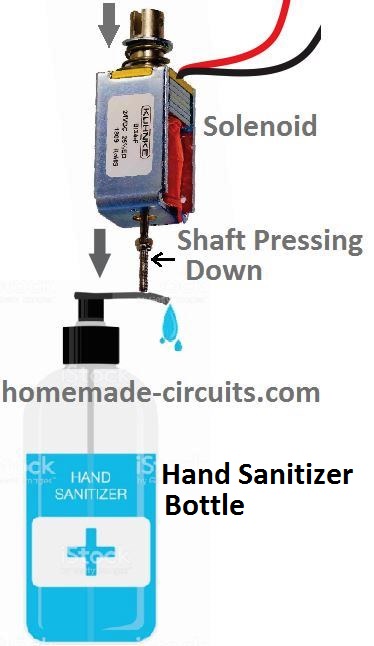
The solenoid in the above image is connected to the output of a monostable circuit.
A monostable circuit is a configuration which causes a momentary high output in response to a momentary input trigger. The output stays high for a predetermined fixed period regardless of the input trigger duration.
In this automatic sanitizer dispenser circuit the monostable is triggered by a PIR as soon as an approaching human hand is detected by the PIR.
The monostable in turn activates the solenoid for some moment of time as determined by its RC timing components.
The activation of the solenoid causes its central spindle to quickly push and pull in the vertical direction, pressing the pump handle of the sanitizer bottle once.
This eventually causes the bottle to dispense the sanitizing liquid into the hand of the user.
Once the user withdraws his hand from the system, the PIR shuts down, and the monostable also deactivates the whole system, until another user brings his hand in the range of the PIR to repeat the procedure.
The monostable triggering circuit for the proposed automatic hand sanitizer dispensing unit can be designed using transistorized monostable or through a popular IC 555 based monostable circuit.
We will discuss both the variants in the following discussions:
Transistorized Hand Sanitizer Dispenser Circuit
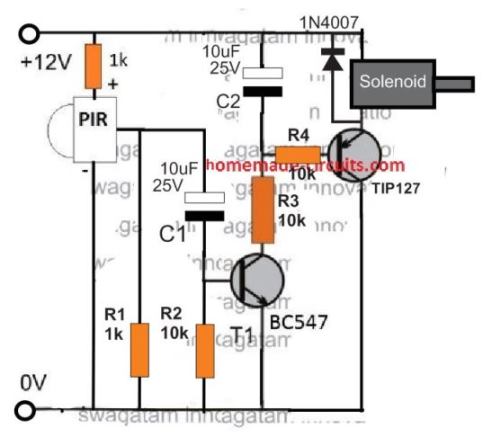
The transistorized version of the circuit looks very straightforward. When the PIR device detects a human intervention, it conducts and sends a pulse to the base of T1 via C1.
The current through C1 instantly activates T1, which in turn activates T2 and also the solenoid pump.
In the meantime, C1 quickly charges and prevents the entry of any further current to the base of T1, thus blocking the repeat DC pulses from the PIR output. This ensures that the system works only momentarily for each detection, and then shuts down until the hand is removed and a fresh cycle is initiated.
This one-shot activation of T1/T2 ensures that the connected solenoid load activates to generate a single push-pull action on its magnetic spindle.
The spindle operates the sanitizer pump handle to dispense a single dose of the sanitizing liquid on the user's hand.
You can notice that the solenoid is connected at the emitter side of the transistor, instead of the regular collector side. The emitter connection actually ensures that the solenoid activates with a gentle soft-start pushing in response to the charging of the 10uF capacitor C2.
If it is connected at the collector side would result in the solenoid being pushed with a sudden thrust, which might not look very impressive.
Simplifying the above Design
The above transistorized contacless hand sanitizer could be further simplified by using a relay as shown in the following design:
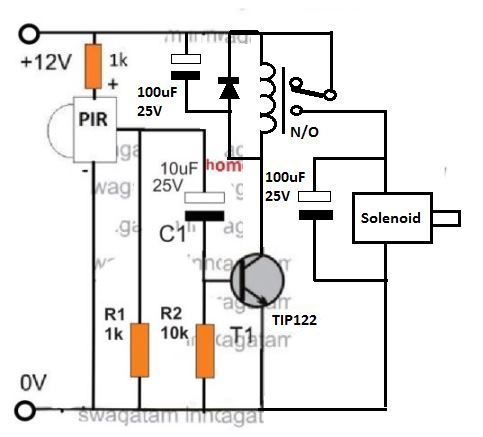
Using IC 555
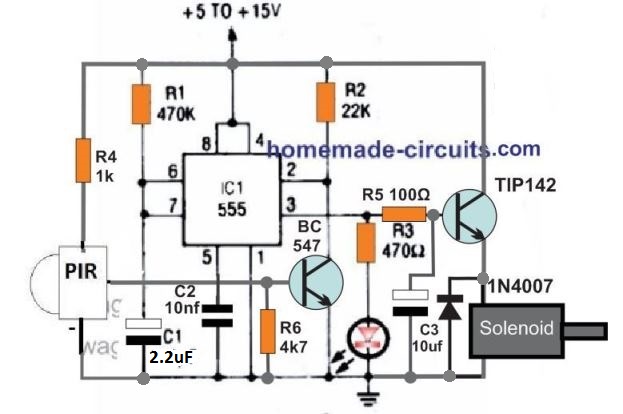
The figure above shows a standard IC 555 monostable circuit. Here, when pin2 is grounded, causes the output pin3 to go high for a period decided by the R1, C1 values or their product.
In this automatic sanitizer dispenser design the R1, C1 is calculated to produce an approximately 1 second output high, in response to a low signal at pin2.
When the PIR detects a human hand, it conducts and switches ON the BC547 transistor which in turn triggers the pin2 of the IC.
This instantly causes the pin3 to go high and activates the TIP142 transistor and the connected solenoid, generating a 1 second long push and then a shut down pull-up on the solenoid shaft.The pull is generated by the attached spring tension on the solenoid shaft.
Again, in this version also the solenoid can be seen connected at the emitter side of the transistor in order to enable a soft thrust on the solenoid shaft depending on the charging response of C3.
An animated view of the whole system can be visualized in the following GIF image.

Infrared Reflective Sensor TCRT5000
Since PIR is a relatively expensive sensor, a cheaper alternative for making an automatic hand sanitizer could be by using the IR reflective sensor TCRT5000.
The sensor is a simple combination of an IR photodiode transmitter and IR photo receiver packed side by side, inside a single package as shown below:

The characteristics of this proximity IR sensor module can be understood from the following data:

From the internal layout diagram of the sensor we can clearly see that the module consist of a photodiode which emits the IR signal towards the target, and an adjoining phototransistor receiver which is positioned to receive the reflected IR signal from the target.
To adapt the sensor in an automatic hand sanitizer machine, we can yet again implement our work horse IC 555 based monostable, a shown below:
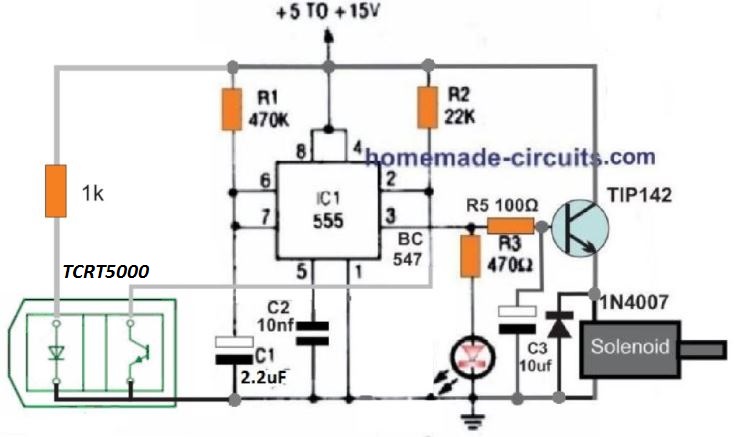
The circuit is quite self explanatory, but if you have problems understanding the details, you can always feel free to use the comment box below for initiating a discussion.
Using HC-SR04 and IC555
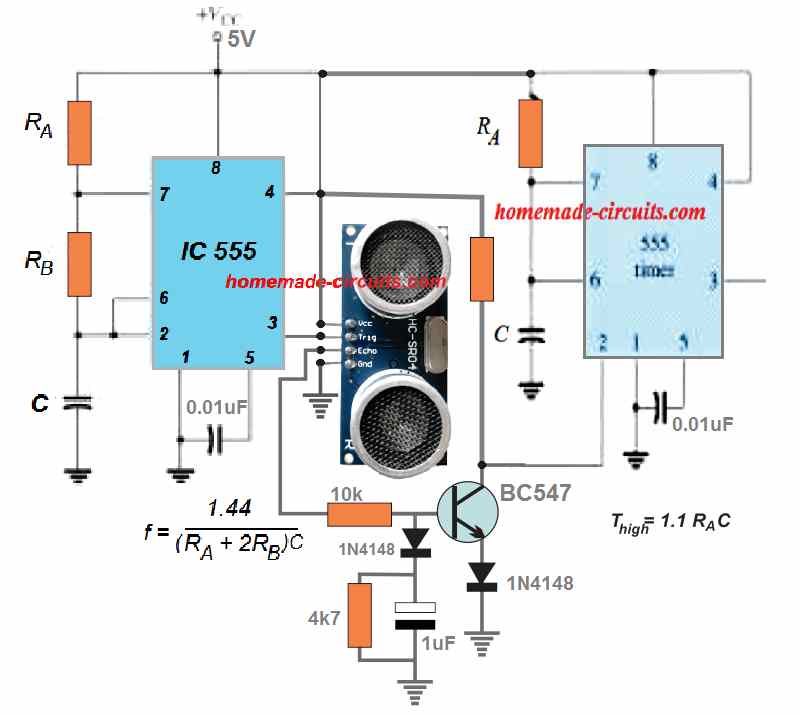
The circuit shown above can be used for implementing an automatic sanitizer dispenser through the ultrasonic proximity detector module, HC-SR04, and a couple of IC 555 circuits.
The left side IC 555 is configured as an astable multivibrator while the right side IC 555 circuit is wired as a monostable multivibtator.
The astable RA, RB, C components values must be calculated to enable a 10us ON and 60us OFF PWM from pin3 of this IC.
The RA and C timing components of the monostable must be adjusted to produce a 1 second high one-shot output from pin3 of this stage.
This output could be used for powering the dispensing pump, motor, solenoid etc as per the requirement of the design.

Have Questions? Please Leave a Comment. I have answered over 50,000. Kindly ensure the comments are related to the above topic.
Hello Sir. I’m designing an automatic hand washing dispenser with detergent, water and drier. I’ve used three IR sensor modules on three op-amps of the LM324. My concern is this: Is there a way I can use only one sensor and a timer, such that the detergent, water and drier will work at different times hence allowing a user soap, wash and dry their hands? I’ve sent you the circuit diagram.
Hello Jedidiah,
How do you want the 3 items to operate at different times with a single sensor? Please explain the working, I will try to help.
I will do the necessary changes in your circuit diagram accordingly…
Thank you Sir.
So the arrangement is: Soap 》Water 》Drier. When one arrives at the soap nozzle, the soap is automatically dispensed and after a predetermined time the water is also automatically dispensed and the user washes and rinses their hands and after that the drier come ON to dry the hand. So the user should operate on time.
Jedidiah,
that’s possible.
We can use a 4017/555 based circuit for the sequential operation of the 3 items, by configuring it with the following circuit. The solenoid can be removed in the following circuit:
Alright Sir. Thank youso much
You are most welcome Jedidiah, let me know if you have any issues with the concept.
Hello, I want to repair a liquid soap dispenser that uses 3 alkaline batteries of 1.5V. Do you have a diagram of the first (transistorized) circuit for those 4.5V or preferably 3.7V?
Hi, you can use the first transistorized PIR based dispenser circuit with a 4.5V or a 3.7V cell also. Nothing will need to be changed except the 1k resistor at the PIR positive, which might need to be reduced a little, maybe to 330 ohms or so.
Ing. Many thanks for the help you give, it is a unique page. You always answer and give the best solution.
I need the following:
1. a simple transistorized circuit or with 555.
2. Function: to use the bathroom when the person enters, it is activated while they are in the bathroom, then when leaving it is deactivated… turning off the light.
3. I have a broken PIR, I could use its sensor, could you send me the modifications.
Thank you Felix, I am always glad to help!
You can try the 2) concept from this article:
https://www.homemade-circuits.com/pir-motion-activated-relay-circuit/
You can replace the relay contacts with 220V AC mains and a series 220V LED bulb for the lamp.
Hi, your website is very good. How can I modify the 555/tcrt5000 circuit so that after activating the circuit for 30 seconds it does not activate again? the activation would only be possible after the reset. Thank you!!!!
Hi, activation for 30 seconds?, Do you mean solenoid should be ON for 30 seconds?
Exactly, when the tcrt5000 activates the 555, the solenoid is activated for 30 seconds. This can probably be done by changing the value of some resistor. But the most important thing is that after 30 seconds the circuit does not reset automatically but stops working until it is manually reset, turning off and on again. Thank you so much.
That can be probably done by connecting an SCR parallel to the LED of the TCRT5000, and the gate of the SCR connected to the emitter of TIP142 through a series diode and resistor. As soon as the TIP142 conducts it will switch ON the SCR. The SCR will latch and keep the sensor disabled, until the SCR is reset again.
The 30 second delay can be adjusted by increasing the value of c1 appropriately.
Thank you so much!!!!
Trying to simulate a circuit in NI MultiSim. I am currently unable to find a proximity sensor for my circuit simulation. Any help will be deeply appreciated.
Can’t suggest much, since I have never used simulators for my experiments!
Thank you very much for your help and advice really appreciate it.
You are welcome!
Just want ti find out. I want to connect 4 × 18650 lithium battries. They rated 3.6v each so 4 will give me 14.4v. See in your diagram you showed 5v connected to pin 8. Can i connect 14.4 to pin 8? Then the diagram on the right see you show RA is that a kind of resistor? And where you show C is it a potentiometer? And last of all the grounds can they all be connected to same place?
Thanks
The ultrasonic module requires 5V supply according to me, so if you use 14V for the 555s, the UC module will need a 5V regulator, and the trigger input will also need to be protected with a 1K series resistor and a 5 V zener across ground.
All the orange rectangles are resistor…C are capacitors.
All grounds should be connected in common.
So what would be better to use then? Arduino pro mini or 555 timer? Is there a big diffrence on battery consumption between the two?
Arduino is the right way to go! Battery consumption will be more for the arduino, but it is the accuracy of the result that really matters
How do you connect 555 timer with hc-sr04 ultrasonic sensor with 3-6v brushless pump with NO Arduino? For automatic hand sanitizer. Diagrams will be appreciated
Thanks Gary
You can do it with the following following steps:
Create a 555 based astable with a 10us ON time and 60ms off time output PWM. This pulse is applied to the trigger of the HC-SR04.
Configure the ECHO pin of the HC-SR04 with a transistorized monostable which requires at least 0.5 second duration pulse from the ECHO pin to switch ON the solenoid for around 0.5 second.
Thank you for the reply you dont perhaps have a diagram? Im still very new to all of the electronic stuff so need to see a diagram so i have an idea what you talking about.
At the moment im using hc-sr04 ultrasonic sensor with 3-6v brushless pump on Arduino uno R3. Want to swap out the Arduino uno R3 it uses far to much power on battries. Want to put a 555 timer in instead of uno. How would i do that plus diagram
Thanks
No problem, I have added the circuit diagram at the end of the above article.
can i get circuit using ultra sonic sesor HC SR 04 , using 555 ic,
sensing-pump on-delay 2 sec-pump off(inspite of sensor on or off).
with regards
Brijesh
I will try to publish it soon and let you know.
Thanks for sharing this. But these doesnt work in outdoor, am i correct, i mean under sunlight,
can you make one with works in outdoor by using sensors like TSOP, ultrsonic sensor etc…..
You can use the LM567 versions explained in the following article, for making the the system immune to sunlight
https://www.homemade-circuits.com/simple-proximity-sensor-circuit/
Thank you. Let me try
Hi sir,
Instead of PIR sensor , can i connect TSOP1738 sensor on 3rd circuit. If yes mean what modification i have to do on 3rd circuit.
Because PIR based ciruit is not working properly in outdoor area
Kindly advice
Hi Prasanth, it is possible but TSOP1738 can be too sensitive and has a long range of detection, so it can detect the surface even a meter away and keep circuit ON all the time.
You can use photodiodes instead….
Hi sir,
I’m going to build 3rd circuit, my doubt is as per your 3rd drawing can i give direct 12v with 1k resistor to TRCT5000 sensor or i have to include any voltage regulator between the main power to resistor to sensor. Kindly advise.
Hi Prasanth, In the last diagram or the 4rth diagram, no regulator is required for the opto, the 1k resistor will not allow the current (If) to exceed 60 mA through the LED of the opto coupler at 12 V, so the LED will be safe.
Hi sir, I’m an Mechanical engineer and im new to this electronics field. I’m having one doubt on 3rd circuit. I’m going to use 12v power to powerup the 3rd circuit .my doubt is How many watts resistor i have to select.
Hi Prasanth, in the 3rd circuit all the resistors are 1/4 watt rated
Hi sir , thanks for your valauvable reply. In last circuit (4th circuit drawing) also we can go ahead with 1/4 watts resistor!!! Am i right sir.
Hi Prasanth, yes all the circuits shown above can work with 1/4 watt resistors
Hi sir,
Question on Circuit no 3 – BC547 transistor is not required for 3rd Circuit? Can you please explain to get better understanding on 3rd circuit.
Prasanth, the TIP122 should be actually a BC547, the diagram is wrongly showing the relay driver transistor as TIP122, please correct it in your circuit
Hi sir , your article is very use full to us to get more knowledge on electronic circuits.
I’m having 2doubts in above circuit.
1. In your 3rd circuit , we have to use TRCT5000 sensor or TRCT5000 Sensor module.
2.can i use normally closed solinoid valve (RO water solinoid device) for the above circuit.
Hi Prasanth, I have provided all the details in the diagram, and the adjoining datasheet of the sensor. You have to use exactly as suggested in those diagrams.
You can use type of solenoid, and adjust the shaft accordingly with the sanitizer bottle mechanism
Dear sir,
Thanks for your valuable reply. I’m planning to go with 12v dc power for 3rd circuit , my doubt is how many amps required to drive the solinoid valve for 3rd circuit. Kindly suggest the suitable dc power adapter specification. This helps me to do this project.
Hello Prashant, the current will depend on the solenoid rating that you want to use. The adapter current will be according to the solenoid rating.
Sir, Can we use thsis circuit for ultrasonic sensor?
Yes sure we can…
Sir HC-Sr04 ultrasonic sensor is i’m using. And it have 4 pin. Could ypu please tell where i have to connect trig and echo pin?
Praveen, The module will require a 10 microsecond pulse at the trigger input which is not included in the above circuits, so this module cannot be used here.
sir, I want to set a timer adjustment for motor off after sometime. Is it done by changing the R1 to variaable resistor? how i can set a preset for the output?
Praveen, in the first circuit it is decided by the PIR 1k and the C1, while in the IC 555 circuit it is decided by the R1/C1 values.
Hello sir,
Thanks for sharing knowledge with so much nice explanation.
I want to ask, Can you please tell us how to implement NEC protocol(Txx and Rx both) with IR and AT89C2051?
Thanks Vaibhav, sorry I have not yet gone through this protocol, so explaining it can be difficult for me at this moment…
Hello Swagatam ,
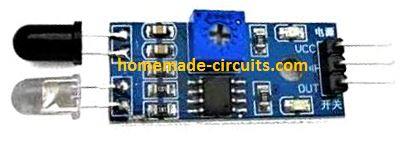
Thank you again for this article. I have been following your other articles on the IR proximity sensor.
I have managed to create one using the LM358 op amp.
In parallel, I have bought a readymade IR sensor circuit commonly available in Flikpart/Amazon.
The issue is that when the circuit ( ready-made) is powered on the output is always high . I have tested with LED and a small pump.
When an object is moved closer it outputs low , thus the motor stops.
But , I need the reverse operation.
What would be the best way to inverse this ? Is relay would be helpful in this case .
I have to drive 3-6V dc pump.
Please help.
Many Thanks
Abhijit
Hi Abhijit,
you can try the following transistor circuit with the module output
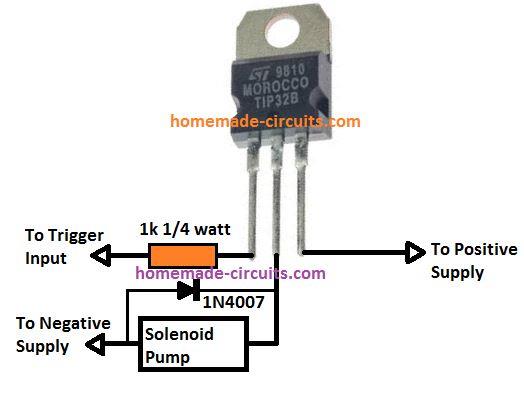
You can replace tIP32 with TIP127 for higher gain and stronger response
hei bro,
i too got same problem. Output always high while connected with ir sensor module. If you edited the circuit and its working please send the screens hot.
thank you
Hi, The circuit is perfect. To verify its proper working you should check the monostable separately and confirm whether the monostable is working normally or not?
But the reverse emf from the motor can disturb the IC, to control this you can try the following modifications in the circuit:
Dear Abhijith, ir Proximity sensors come with mainly two versions. One employe an smd ic LM 393 and the other with LM 358. The first version outputs a LOW when ir signal is detected and the second one outputs a HIGH. Check Ur sensor ic first. If LM 393,it’s better u use a pnp transistor to get the desired functioning.
Hello sir
can we make the first circuit with ir sensor and tp122. how will i have to make the circuit .
can you please support
Thanks
Arjun
Arjun, you can try the following configuration
Hi swagatam… can I connect 12v submersible pump instead of solenoid in above circuit??
Hi Nirav, yes you can. For relay operation, the relay can be actually connected directly across pin3 and ground of the circuit, no need of any transistor stage. Just make sure to add a 1N4007 diode across the relay coil.
is programming required for the circuit
hello sir
your circuit diagram and explanation gave me amazing guidance….
i have created my final circuit but before trying and ordering the components it would be great if you could give any advice and make corrections (if any)
the link to the circuit is :
https://drive.google.com/file/d/1P5XRoket4WPOYz3bOnq2wHzHrj846u7D/view?usp=sharing
also, i have a few questions which i would like to ask:
1. what should i use as the battery source (9V battery, regulated to 5V or a rechargeable battery)
2. what should be kept in mind while choosing the npn transistors
3. it would be great if you could check whether these resistor values are good to go.
Many thanks.
Hello Shubham, your circuit is not correct, it has to exactly as per the diagram provided in the above article.
Many thanks for your response… will follow your circuit…
However, i wanted to ask which battery should i use?
> 9V battery
> 9V battery regulated to 5V
> Rechargeable lithium battery
Also, TIP142 transistor is not available to me… so what can i use as an alternative?
Many thanks .
You are welcome. The driver transistor value and the supply rating will directly depend on the specifications of the solenoid. If you can provide its specs, I will try to solve it.
i am using 3-6V DC submersible pump
(the small mini white pump)
ok, so you are not using a sanitizer bottle mechanism I guess, in that case a TIP122 transistor will do the job
Hi on Circuit 4, how is the connection for BC547
Hi, there’s no BC547, the print is mistakenly not removed
how I can add a timer in this Project for 2 seconds.
sensing —- pump ON — delay 2 seconds —– Pump OFF (not matters sensor is on-off)
By adjusting C1, C2 in the first diagram, and C1, C3 in the IC 555 diagram
I tried different values of c1 and c2 in the first diagram and I also tried different values of c1 and c3 in the IC555 diagram.
In the first diagram, the output is generated after I shifted (remove) my hand in front of the sensor.
So, how I can generate a 1 or 2-second timer. when the input from the sensor is continuing and the timer should be off after 1 or 2 seconds. I hope you can understand my problum..
If your PIR does not work correctly then your circuit will also not work correctly.
First check the circuit without a PIR. Remove the PIR and connect the R1/C1 junction with the positive line, check how the circuit responds.
The exact same response should be achieved with a PIR also, if not then you must diagnose why your PIR is not working.
Again, the ON/OFF timing can be set by suitably varying the mentioned capacitors.
sir, I am using the IR sensor.
OK, so remove it and test the circuit by manually touching R1/C1 common junction with the positive. The solenoid should activate and deactivate within 1 or 2 seconds. If this works then your IR sensor or connections may be having problems.
Hi swagatam….
My PIR sensor gives two times output logic 1on one time interrupt.. any idea why???
On the other side … my arduino resets some times when motor switched on using tip122. 1k resistor is connected to base . And motor and atmega 328 supplied with same source…
Hi Nirav, please check your PIR output separately by isolating it from the control circuit. Check the preset and switch positions and set them correctly to get a single click ON/OFF output.
To stop the back emf from the entering the Aduino, connect a 1000uF capacitor across the Arduino supply points, and also connect a 1N4148 diode parallel to this capacitor, cathode to positive and anode to negative side. Additionally connect the positive line to the Arduino through a 100uH inductor.
Sir can you please make a circuit diagram which uses ir sensor module and a 6v dc pump with adjustable time of dispensing.
I tried with the second circuit with the above component but it didn’t work as expected.
Kindly send the circuit sir.
Vishnudas, the IC 555 circuit is very basic and accurate and it has to work, you must try to find out why your circuit is not working? You can connect an LED in series with the BC547 base to understand whether the PIR is switching the transistor correctly or not. Before connecting the PIR you must check and confirm that your monostable is correctly configured and is working.
Thank you for you reply sir.
I have built a proper monostable circuit of 555. And I have used a IR sensor and not PIR.
The problem I am facing is that the pump is not pumping at proper time. If it starts to pump it doesn’t stop.
(But monostable circuit output led is working correctly)
Can you please guide me in this process.
Hi Vishnudas, if your monostable is working correctly then the load should also work correctly?? because the pin3 from the IC is driving the load.
Initially, you can remove the sensor and manually touch the pin2 with ground to check and verify your circuit response.
OK, if the pin3 LED is responding but the load is not, then may be there’s some leakage voltage from pin3. Please do this, connect another LED in series with the TIP142 base connection, this LED will ensure that the driver transistor correctly switches ON and OFF and operates the load accordingly without ant flaws.
When this LED is ON the transistor and the pumping will be ON, when this LED switches OFF, the pumping will also switch OFF.
You can also connect the load across the positive and the collector of the transistor instead of the emitter, to ensure better response from the load.
Hi,
Couple of doubts. (555 ic Circuit with ir sensor)
1.Can i use tp122 instead of tp142. My load is a 6v dc motor.
2.to avoid leakage I will use a led at base of bc547
3. Will output stop after some duration
Thanks in advance.
Hi, You can use tip122 if the motor is less than 3 amp
The output from the PIR will be hardly 3.3 V, so an LED might not work. You can add a 1N4148 diode instead. But try LED also to check if it works or not
The IC 555 is monostable so naturally the output will activate only for a few seconds
Hi
I have tried the setup with 555 ic and IR tx Rx combination.
But I see that the output remains high when hand is kept in front of the IR RX. Why is this ?
If hand is removed instantly then it turns off the motor after 3 sec.
My R1 and C1 is 35k c1 is 100mic
I have used tp122 instead of tp142..
Why is this ?
Can you please check why the circuit output is not stopping even after sometime when my hand is in front of the IR receiver Rx.
When hand is removed instantly then after the delay it stops.
I don know why can you please check.
You can check the IC 555 monostable operation first by removing the Rx, and shorting the pin2 of the IC to ground. When you do this, the motor should operate momentarily and then switch OFF.
By the way did you calculate the 35k, and the 100uF capacitor correctly for getting a 2 second switch ON for the motor??
Hi
I tried that even then it is continuous when connected to ground. When pin 2 is low or connected to -5v it is continuously running and not stopping. I have checked the circuit twice for any wrong connection all are correct as per the setup.does circuit stop output if the pin two hasn’t come out of ground ?
What is it am I missing.
C1 and R1 is calculated since I required more time duration.
Hi, that simply means your 555 monostable circuit is not correct. Change the IC, or check online for IC 555 monostable circuit and compare your design with it for troubleshooting
Same type of problem I am having… if I give separate supply to load than circuit works perfectly.. means my DC pump automatically off after 1sec. But if motor supplied with the same supply of circuit then circuit resets..
I’m using bc547 followed by tip122 to operate relay.. without connecting motor 555 works perfect in monostable mode. As I connect motor to circuit it malfunction.
If you are using a relay then TIP122 will not be required, you can use a BC547 for driving the relay.
The resetting is happening due to the motor back EMF. Did you connect a reverse diode across the motor? If not try connecting it.
If you have already connected it, then also connect a 100uF/25V capacitor also across the motor.
After this connect the voltage source directly to the motor, but through 100 Ohm resistor to IC 555 monstable. Additionally, connect a 12V zener across the supply lines of the IC 555, and another 100uF/25v right across the IC 555 supply lines.
Hey thanks it worked…
Now once I pour sanitiser in the container, motor some times stops after 1sec, but mostly motor doesn’t stops after set time. Without sanitiser circuit works perfectly… i think I need to work on my relay switching circuit.
My connections after pin 3 of ne555 are,
From pin 3 to 100k on base of bc547, collector connected to VCC, emitter 10k to ground. From emmiter of bc547 to base of tip122, emitter of tip122 ground and coil of relay connected between vcc and collector. 10uf 63v on Base of tip to ground.
Pls guide if any correction is needed…
Hi, Glad it is working now, however your relay driver stage is an overkill. there’s no need of the TIP122, you just have to connect a BC547 with pin3 via a 10k resistor and operate the relay.
Please see the diagram presented in the following article, and modify your circuit accordingly, and the check the response
https://www.homemade-circuits.com/how-to-make-relay-driver-stage-in/
Can we set a time delay of 1 to 2 secs in the circuit if we want to operate the motor for a short while?
How do we set it???
You can set any desired delay by adjusting the relevant timing component values. Adjust R1, C1 in the second diagram accordingly by trial and experimentation.
Can we use this circuit for 12 V DC
Thank you very much Sir for your time and response. My self being a mechanical engineer, may of the terms go out of my head. I am sorry for silly question. The water pump I used is 3-6V DC submersible pump. How do I find Ah rating for that? And with consideration of IR sensor and PNP transistor voltages, can you guide me for an appropriate battery set please. Thank you for your time and guidance. I am enjoying your site with so many innovations, and trying to learn basics now. Thank you again for your time.
Thank you Shekhar, is the motor a small white colored one which is available from amazon, flipkart etc. If it is, then its current consumption is somewhere around 200 mA, which means the battery should have an Ah rating of 1 Ah, and the battery should be a 3.7 V 1 Ah Li-ion battery, the one which are normally used in small mobile phones. The IR sensor is not relevant to the load, it can be any standard photodiode. for the transistor you can use a BD140 transistor or a 2N2907
Thank you very much sir. Yeah, i bought pump from Amazon. I will try to connect again with your recommend battery capacity and keep you posted. Thank you very much for your help and guidance. When your time permits, if you can teach on the calculation part to determine 3.7V 1 Ah battery, that will be great. Thank you again for all your help and guidance.
One point puzzles me is, I used 4 X1.5V AA Duracell batteries giving 6V and it has 2.6Ah. and your suggestion is to use 3.7V 1Ah, which is less than what I did use. So how does this works better?
And since pump uses 200 mA, using 2.6Ah AA batteries, shouldn’t the circuit work for at least 10 days? Why did batteries drained in 4 days? Sorry for my silly question.
Hi Shekhar, alkaline battery and Li-Ion battery work on different principles. Li-ion can withstand higher discharge rates than any other standard forms of batteries, while alkaline batteries cannot withstand high discharge current and may start degrading quickly, causing lower efficiency results.
At 200 mA continuous discharge your alkaline battery should last for 10 hours, not 10 days. So for intermittent use, 4 days back up looks quite OK to me.
Thank you very much sir again for your time and guidance. I understand now. I will try to work on my connections again & I will check how do I connect 3.7V 1 Ah battery & I may have to figure out rechargeable option for this? I will explore more in Google . Thank you for all your time and help. I am learning while I am working on these and your guidance is awesome. In case if I want to reach out to you for any further questions on any of the hobby projects I do or guidance or if I want to share the circuit for your suggestions, how do I do? This is all I started as a hobby with Arduino, therefore my basic knowledge is minimum. Again , thank you for everything and stay safe.
No problem Shekhar, I’ll try to help as far possible, for external diagrams you can upload them to any external free image hosting site and provide the link to me, I’ll try to solve it for you.
Thank you Sir. Have a great evening and stay safe. I feel lucky to find your blog. Thank you for all your guidance.
Thank you Shekhar! You too stay safe!
HOW CAN WE USE 3.7V BATTERY FOR THE 555 TIMER AS ITS INPUT VOLTAGE RANGE IS MIN 4.5V.
I HAVE A 18650 LI-ION RECHARGEABLE BATTERY (3.7V 2200mAH) ALONG WITH TP4056 CHARGE/DISCHAGE PROTECTION MODULE. HOW CAN I USE THIS BATTERY WITH THIS CIRCUIT? SHOULD I USE A DC-DC BOOST CONVERTER?
ANY ADVICE/SUGGESTION WOULD BE GREAT.
THANKS
You can use an LM555 which is a CMOS version and works with 3 V also
https://www.homemade-circuits.com/cmos-ic-lmc555-datasheet-works-with-1-5-v-supply/
but make sure the solenoid also is rated at 3 V, and connect the solenoid at the collector side of the transistor, not on the emitter side.
I AM USING 3V PUMP SO THAT WILL DO THE JOB I GUESS
BUT HOW DO I TELL IF THE IC I HAVE WOULD WORK ON 3V?
IF ITS NOT THE CMOS VERSION, WHAT SHOULD DO?
BTW, WHY CONNECT IT AT THE COLLECTOR SIDE AND NOT AS PER THE DIAGRAM ABOVE?
THANKS
Yes that will do. If the IC is LM555 then it will be CMOS type
If it is not CMOS, you can use two 3.7V in series. The pump will handle it since it is supposed to activate only for a second.
The collector side will give higher current and rapid thrust.
Emitter side will be softer.
This is really nice. I am a mechanical engineer and made one using Transistor (PNP), IR sensor and Sebmercible water pump and connected to 6V supply. But batteries get drained in a week. Any suggestions?
Thank you for liking the project. Any form of motor or solenoid will require a significant amount of current to operate which can drain any battery quickly, if you want the battery to last long make sure the battery is a li-ion battery, with Ah rating 5 times higher than the pump.
I tried the pir circuit it’s turns on as I plug in without connecting pir and stays on
Even if their is no connection between R4 & base of bc547
R4 is at the base of TIP127, please do it only if you know the basics of electronics.
without base bias the TIP127 cannot turn on, please check your transistor or replace it with a new one.
The monostable 555 using tip142 circuit bro with timer ic using pir sensor not the first one ,it turns on without sensor trigger it’s kind of important please help me out
Thank you
Without R4 a positive voltage cannot reach the base of BC547, so BC547 cannot conduct. With BC547 not conducting pin2 of the IC cannot be grounded and the monostable cannot be triggered. You can do one thing, first confirm how the BC547 is getting triggered? Alternatively, you can connect a 1uF or 2.2uF capacitor parallel with R6 and see if this solves the issue
Can we use 1st circuit with 5v power supply?
yes, if the solenoid is also 5 V rated
How to replace pir sensor with ir sensor like tcrt5000???
I will try to update the design soon in the above article.
Hi sir! i’m one of your innovation follower from ethiopia. please can you tell me the specifications of the PIR and solenoid so as to order them from stores?
with respect!
Thanks Habtamu, the PIR can be any small PIR like the one shown below
The solenoid will need to be experimented to ensure it has sufficient power to push th sanitizer pump deep down. According to me a 12 v 2 amp solenoid should do the job well.
Hello Sir,
This is Usama Asif. This Website is really made a great effort for us. Sir I just need some more details and Calculations about first circuit(through Transistors) of Automation Hand Sanitiser.
Hope to get response immediately.
Thanks!
Thank you Usama, the transistor base configurations are simple RC circuits, which switches ON the respective devices when the charge reaches 0.7V value.
You an read more about RC circuits here:
https://www.homemade-circuits.com/how-rc-circuits-work/